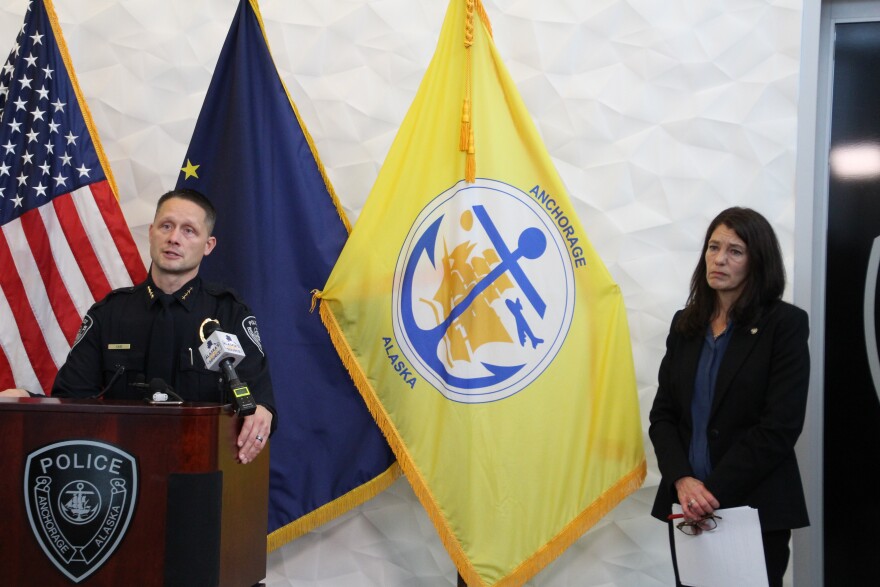Anchorage police are soon getting $12 million in technology upgrades, including new drones, license plate readers and better security camera coordination.
Anchorage Police Chief Sean Case called the slate of upgrades “exciting.”
“This puts Anchorage, when it comes to our ability to respond to crime, respond to community problems, respond to the needs that we've been hearing about for a number of years, in a category that's at the top around the country,” Case said.
Case said the new equipment will boost public safety and help officers deescalate dangerous situations. The upgrades come after the Anchorage Police Department faced criticism for a string of fatal officer-involved shootings. But some worry about how the new technology will impact residents’ privacy.
On Tuesday night, the Anchorage Assembly approved the five-year, roughly $12-million contract with Axon Enterprise to supply the new technology. It’s the same company that supplies officers’ body cameras. Most of the cost will be paid for by the annual tax levy Anchorage voters approved in 2021 to fund the body cameras, Case said, with any amount not covered by the tax coming out of APD’s wider budget.
“We're not gonna have an ask from the Assembly to supplement this,” Case said. “This is something that we're just gonna have to find ways of paying for this in our budget.”
Case said one of the big new tools the department will now have is called the real-time crime center, a hub connecting many cameras — up to 750 — to a centralized network. Those cameras will include police body cameras, traffic cameras, and other city cameras like the ones at the APD headquarters and the ones set to be installed at Town Square Park. Case said he hopes to add potentially hundreds of home and business security cameras to the network as well, if residents agree to share access.
“Once we have access to their feeds, they control what we get access to,” Case said. “It can be 24 hours a day, seven days a week. It can be some cameras, not all the cameras. Their retention schedule is completely in control with them.”
Case said city cameras only keep a backlog of 14 days of footage, then it’s erased unless it’s pulled in as evidence.
Police will also soon get updated drones that can launch remotely, and will provide a public dashboard of what crimes were responded to and flight paths the drones take. Case said the goal is to have the drones arrive at high-pressure situations before officers, in order to give them a better sense of what to expect.
“They can come in with the right tools and the right level of response,” Case said. “It's going to cut down on us coming in too hot, because we just have better information. So it's part of the overall de-escalation kind of ecosystem, if you will.”
While technically the drone cameras could capture video footage the entire time they’re active, Case said the goal is to only record when the drone arrives at a crime scene and to try to point the camera away from the ground while it’s en route, in order to better protect residents’ privacy.
Case said the police are also updating their outdated tasers.
“The current tasers that we have, can't buy them anymore, can't get replacement parts,” Case said. “It's older technology. We only have about a 20-25% success rate with our tasers, which means that officers are a little more hesitant to use them, particularly when you have a weapon involved.”
He said the new tasers have nearly double the range as the current ones, and are better at getting through multiple layers of clothing, an issue that’s particularly prevalent in Alaska.
“People in Alaska wear a lot of clothes, and therefore you have a failure of tasers,” Case said.
Another upgrade: adding license plate readers to police vehicle dash cams.
“The cameras will automatically be running the license plates, and it will only notify the officer and dispatch on a certain level of crime,” Case said. “So if it’s a stolen vehicle, if it's a vehicle that may be involved in drug distribution, an active case, a homicide suspect, violent felony warrants.”
Case said at this point the plate readers will be calibrated to ignore smaller misdemeanor offenses.
“Maybe sometime down the road, the public's interested in us doing that,” Case said. “But we want to make sure that we keep it pretty tight and contained for things that are more serious.”
APD is also slated to connect with a service called Auror, a private platform used by retailers to record and report thefts in their stores. Case said there are many Anchorage stores that use Auror to build internal shoplifting and trespassing cases and share them with nearby businesses. Case said the new upgrades allow Auror users to share those cases directly with APD.
“We'd be able to review that information and immediately go get an arrest warrant for that individual, cutting down drastically on the wait time… the detective work that the detective’s got to do,” Case said.

Case said the upgrades will not only modernize the department, but also cut down officers’ use of deadly force. They come after a tenuous time for the department. Since Case’s promotion to chief last July, officers have shot nine people, killing five of them. One of them was a teenage girl who was holding a knife before she was killed.
That prompted Mayor Suzanne LaFrance to announce a slate of reforms aimed at reducing use of force, and Case said the technology upgrades are part of that effort.
“You know, a year plus ago, when we talked about having some of these goals, that wasn't just something we said to get through a crisis,” Case said. “Like, we meant it, we mean it, we're putting forth a lot of energy and time.”
However, at least one member of the Assembly is concerned with how the upgrades were presented. Assembly chair Chris Constant was the sole no vote on the contract that approved the technology purchase.
He said for over a year, the Assembly has been trying to get information from the city on its privacy policies around traffic camera footage, eventually giving officials an October deadline. Constant said he expects a policy for the new technology would be even more complicated.
“If it's that much work to get a policy for traffic cameras, which are static and right above every intersection and not following people around from intersection to intersection, then these policies are more intricate and challenging, in particular, as relates to people's privacy,” Constant said.
Constant also said he felt the contract came before the Assembly rather quickly, and he wished they had more time to go through what they’re paying for.
“It just feels out of order to me,” Constant said. “It's not yet ready. But my peers and the wisdom of the body, it was 11 to one, ready to go. And so Anchorage’s leadership is ready for this brave new world of real-time crime center policing systems.”
Despite his vote, Constant said he has faith that the LaFrance administration and the police will adequately protect Anchorage residents and their privacy in their forthcoming policies surrounding the new cameras.


